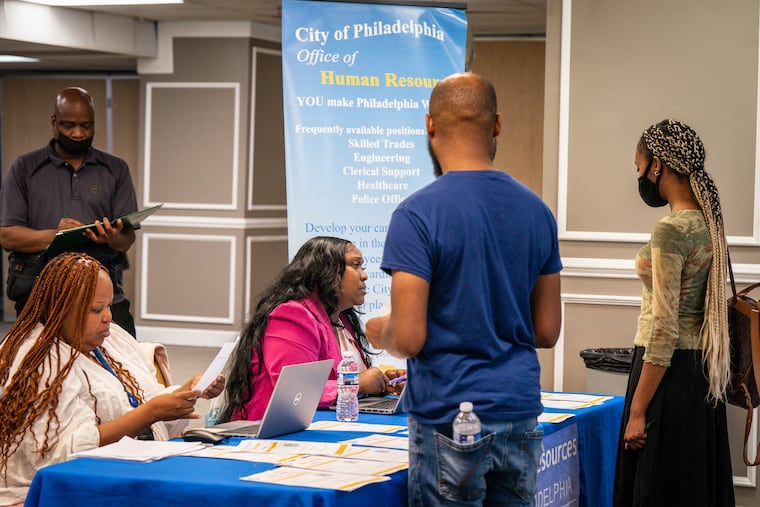‘Let the candidate do the talking’ and other advice for hiring managers from an HR expert
An interview is a test and should be conducted like one, says Anna Papalia, a Philadelphia-based human resources expert.

Anna Papalia is a Philadelphia-based author and human resources expert who has advised more than 10,000 students, entrepreneurs, senior executives, hiring managers, and job seekers in all industries on the best techniques for interviewing — and being interviewed. Her first book, Interviewology: The New Science of Interviewing, will be published at the end of January by HarperCollins.
Papalia spoke with The Inquirer about common mistakes hiring managers make, interviewing in person vs. over a video call, and more. Responses have been lightly edited for length and clarity.
What is one mistake that hiring managers seem to always make?
There’s this belief that interviewing is like dating: kiss a bunch of frogs and you’ll eventually figure it out. Or just have a conversation and see if you click with them. Those are the worst things that you could do. An interview is a test and should be conducted like one. For hiring managers, this can be challenging, especially if you’re highly extroverted and you like to talk to people to make a connection. You need to have structured interview questions.
What do you mean by ‘structured’ questions?
Structured questions should be derived from the job description. You shouldn’t be asking candidates, “What color crayon are you?” Those are called personality questions. There’s a time and place for those. If it’s pertinent to the job, absolutely ask, but we need to make sure that you’re asking relevant questions. You can start with an open-ended question like, tell me about yourself, or walk me through your resume. Get the candidate talking. Then you can drill down with technical questions. Unfortunately, many hiring managers don’t examine their job description or the needs of the position. They oftentimes talk too much, too. Let the candidate do the talking.
Do you think it’s effective for more than one manager to be interviewing a candidate at the same time?
That’s a panel interview, and it’s helpful for hiring managers because making decisions about who to hire is complex. In my research, there are charmers, challengers, examiners, and harmonizers. I coach corporate hiring managers and teams to do panel interviews and have a rep from each style. It might be slightly more intimidating to the candidate, but it’s better for the hiring process because someone may say, “I really didn’t like the way she answered that.” The other hiring manager who’s their opposite, will say, “Well, I really liked that.” And you get that back and forth in those different perspectives.
What’s better: online interviews or face-to-face?
Whether it’s online or in person, it doesn’t really change the interview. The only thing that changes is that candidates need to try a little harder on virtual interviews to get their point across. Both parties need to show more energy.
Does setting matter? Is it OK to interview a candidate in a Starbucks?
Would you want to be interviewed in a Starbucks? [laughs] Honestly, I think hiring managers should put themselves in the shoes of the job seeker. An interview is a nerve-racking event for both people. Even hiring managers are a little nervous. You need a quiet space where you can listen to each other. It’s often an intimate one-on-one conversation. You’re asking them deep questions about their career. Do you want to be doing that in a public space?
How many times should I be interviewing a qualified candidate?
That first impression is so powerful. But that’s also a good tip that we might be a little biased, right? You should meet with someone two or three times. The first round is usually a phone screening to vet them or to see if they’ll be good to come in for a full interview. Then have an in-person, one-on-one hour-long interview, maybe you’re co-interviewing with someone else, and a third round with you and maybe your business partner. You need different opportunities to meet with that candidate because job seekers are very good at being the best version of themselves to get their foot in the door. We need to give ourselves multiple opportunities to counter some of the potential biases.
How important is the resume?
Very important. Recruiters typically spend four seconds scanning resumes so it needs to look right. For example there can’t be any typos — research shows that 72% of hiring managers pass on anyone that has a typo on their resume. Also, you don’t need to include an objective. We know your objective is to get a job. We don’t need your hobbies. All we need is your executive summary, experience, and education.
What about LinkedIn instead of a resume?
Be careful. LinkedIn can be biased because it can contain personal interests and also a photo.
Speaking of bias, how do you avoid this in the hiring process?
Be careful about “culture.” Unfortunately when hiring managers say “we’re looking for a culture fit” it actually means that they’re making a biased hire. You don’t have to look for someone who fits into your culture. There’s wonderful research that tells us when you’re in a homogeneous group, people who are the same age, same gender, and think alike, you’re less creative. Diversity enhances innovative teams.